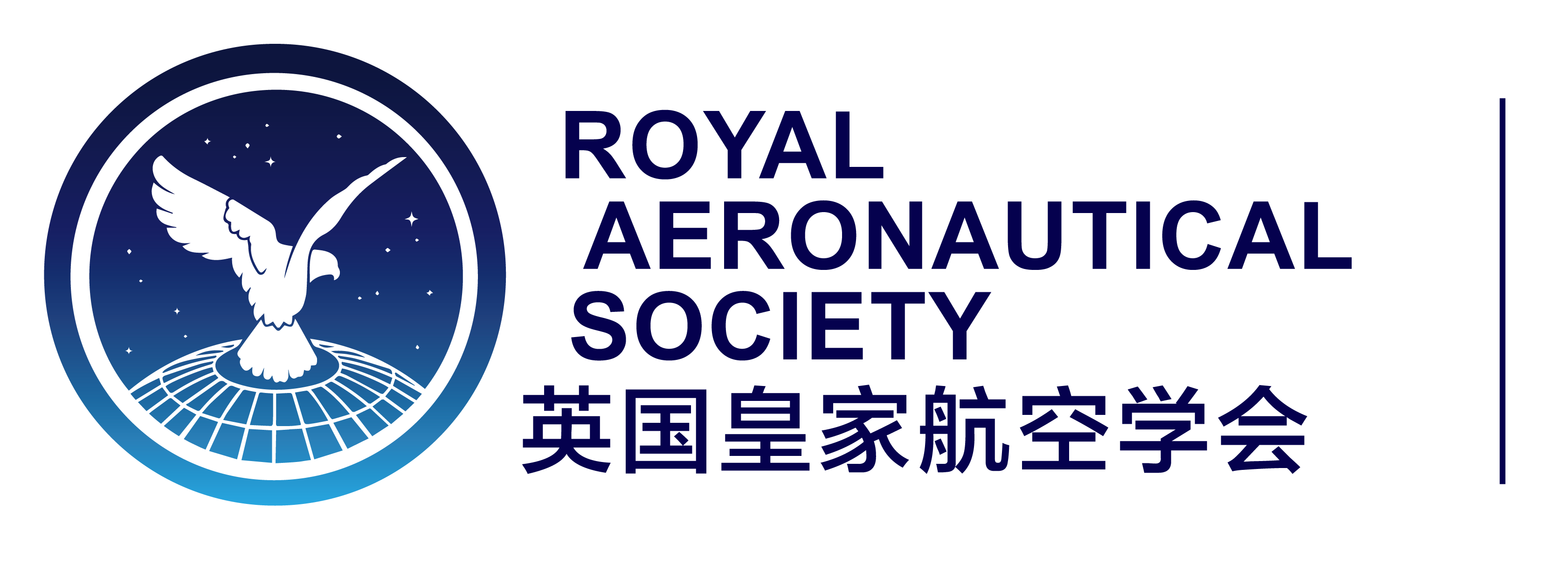Cabin "Boom" - Review of the 2023 Hamburg Aircraft Interiors Exhibition in Germany
Acceleration is seen as one of the core signs of the aviation industry's recovery from the impact of the global epidemic: including the acceleration of previous trends, as well as the growth rate of the industry itself.
This accelerated development is entering a new phase in the design of cabins, from seats to cabin signs, lighting, in-flight entertainment and more, all of which will be showcased at the Aviation Interiors Expo in Hamburg, Germany in June. This is an influential trade show for the aviation interiors industry.

Image: In Air New Zealand's Skynest concept, long-haul economy passengers can book a flatbed berth to rest. Sleeping in a Skynest berth will cost NZ$400-600 per four hours.
"Many of the trends we are seeing in cabin interior design have become very evident over the past few years,"Lukas Kaestner, president of the Crystal Cabin Association in Hamburg, Germany, which is like the British Academy of Film Awards or the Oscars for cabin interior design.
Kaestner cited as an example the importance of "bandwidth for in-flight connectivity and addressing accessibility issues in seats, toilets, etc." He also pointed out that in this year's Crystal Cabin Awards, they also noticed some products for electric vertical take-off and landing aircraft and airlines, such as Lufthansa's Allegris cabin or Air New Zealand's Skynest. For them, this shows that the impact of the epidemic is over, and suppliers, design agencies and airline partners are getting back to work and implementing new passenger experience strategies and innovative concepts.
The same , but different
In this context, Rhian Bache, Product Manager at STG Aerospace, a Welsh interior lighting specialist, said: “Airlines are being forced to upgrade their older aircraft due to production shortages at OEMs. STG Aerospace has been asked to provide lighting solutions for the Airbus A319 and even the Boeing B757, which has an average age of 27.5 years. It is clear that there is a growing demand for cabin retrofits, but we must also look at this from the perspective of budget airlines, who need to differentiate themselves from their competitors through the use of cleverly chosen interior colours in the cabin to resonate with passengers. However, this task is difficult when the budget for the upgrade project is limited.”
Rhian Bache suggests that for many airlines, “low-risk customization appears to be the answer to the above problems, with more airlines choosing standard catalog options and applying their own signature colors and interior materials to reflect their brand values. Rather than designing a new product from scratch, it is better to improve existing products, providing a low-risk and effective solution to achieve a consistent passenger experience.”
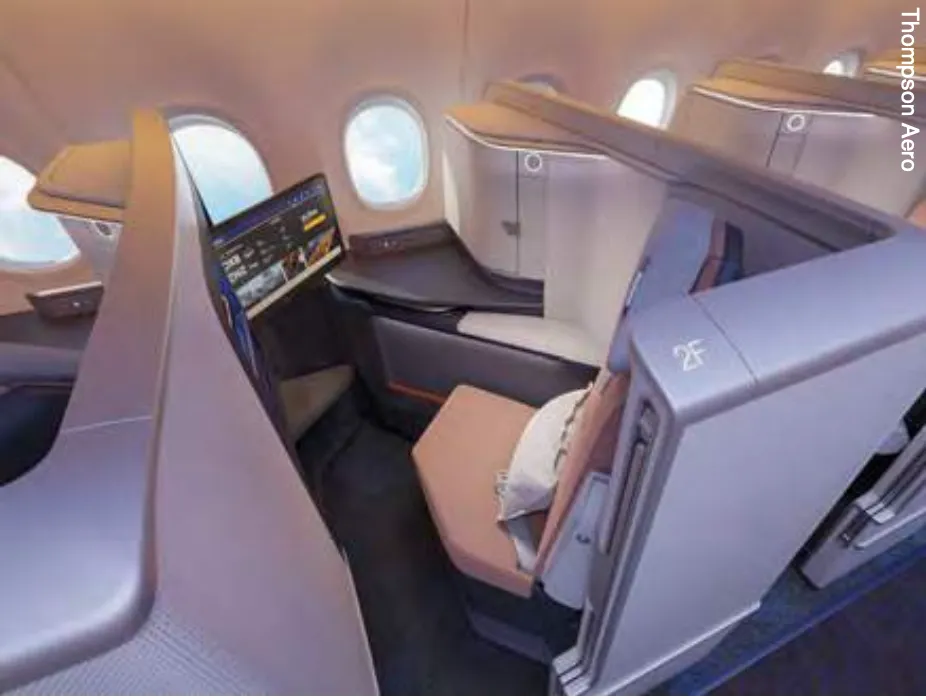
Single -aisle long-haul
However, on the commercial side, these single-aisle long-haul aircraft require a completely new seating product, as the width of the aisle in business class is much greater than the space on the aisle in wide-body aircraft. In short, the space that replaces the 3-3 economy class layout is equivalent to the 3-6-3 wide-body aircraft - something that has never been seen before.
The industry’s solution to date has been primarily herringbone seating, often as business class mini-suites with doors, starting with JetBlue’s Mint Studio (with Thompson’s Vantage Solo product) and continuing more recently with flydubai’s newest business class (with Safran’s Vue suites). Basic geometry suggests that herringbone seating is likely to continue to dominate in this regard, rather than staggered seating.
There are special challenges in terms of seats, especially in premium cabins. In economy class, single-aisle long-haul means more full-function seats that are usually deployed on long-haul wide-body aircraft. There is a seemingly contradictory situation here: more seats, but also fewer seats.
More seats per row, as the nine-abreast layout of the spacious Boeing 777 and Airbus A350 is being retired or converted to a 10-abreast layout, such as the slightly more spacious Airbus A350 "new production standard" launched this year"
However, there are fewer standard economy seats overall as extra-legroom economy sections (such as United Economy Plus) and full premium economy suites (such as British Airways' World Traveller Plus) continue to take up more space in the cabin, and airlines are increasingly looking to spacious business class mini-suites in the nose of the aircraft.
Essentially, we saw the densest narrowbody (the all-economy low-cost A321neo seats nearly 240 passengers) and the most spacious widebody (United's premium business 767-300ER has 46 seats in business class, 22 in premium economy, 42 in extra legroom economy, and just 57 in regular economy)Even up front, however, density is key, with the latest generation of business class seats optimized to the extreme. Lufthansa’s Allegris product line is an optimization of existing concepts. The basic layout is the same as the United Polaris from the late 2010s, and this seven-seat business class seat simply makes better use of the space: more room in the front and back rows, enclosed footwells, etc.
Even up front, however, density is key, with the latest generation of business class seats optimized to the extreme. Lufthansa’s Allegris product line is an optimization of existing concepts. The basic layout is the same as the United Polaris from the late 2010s, and this seven-seat business class seat simply makes better use of the space: more room in the front and back rows, enclosed footwells, etc.
Back to the economy class discussion, Chris Robinson, chief industrial designer at Norfolk-based Mirus Aircraft Seating, said:“Recent efforts to achieve greater cabin density by making seats thinner are problematic because one of the biggest challenges we face as an industry is the loss of passenger comfort.”
Robinson pointed out:“Emerging technologies will continue to improve the level of support we can provide while reducing seat cushion thickness, and our design team is working to improve passenger comfort through ergonomic research, improved tactile feel and visual design cues.”
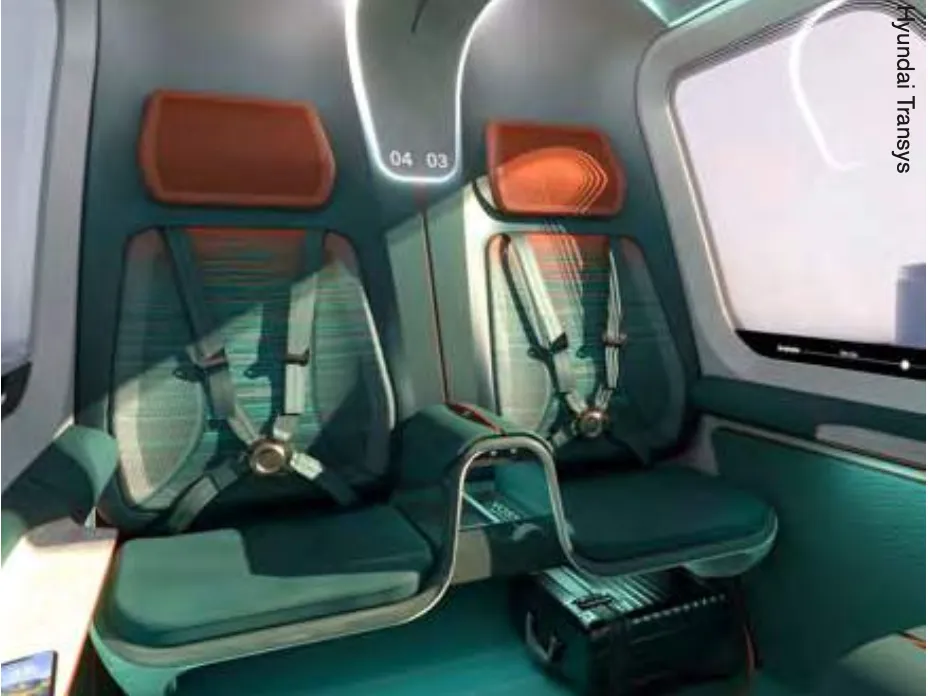
Supply chain capacity
Collins Aerospace Mark Vaughan, Vice President of Cabin Experience at:“I think the biggest challenge we face is the health of the supply chain. The global cabin interior supply base has a complex and diverse global layout that requires constant attention and interaction with the supply base at different levels. These challenges must be managed on a daily basis to improve the overall health of the interior business.”
This management is very complex: not only is the manufacturing of airframes distributed around the world, but aviation manufacturers themselves also pause, restart or speed up production when problems arise. For example, Airbus faces problems with the A321XLR fuel tank, Boeing continues to have 787 quality problems at its Charleston plant, and 737 MAX production can also be intermittent. These factors increase the complexity of supply chain management.
The problem is really about supply chain infrastructure and logistics, which have already built a world of on-demand manufacturing in industries such as large-scale automotive. However, aviation is still in many ways the most impressive small-scale industry in manufacturing. Solving supply chain problems requires investment, and someone needs to take action first.
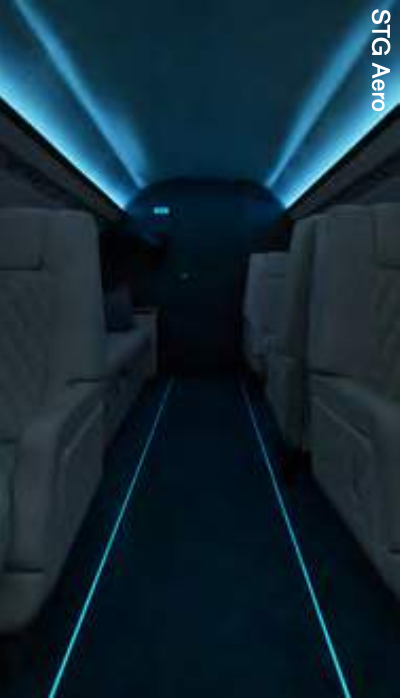
Skills , certification and capacity
Brexit effects
The logistical issues of getting innovative, UK-made new seats and other cabin products to the test are also prevalent. In the past, a seat could be trucked to a major European aerospace company for crash, flammability or fire toxicity testing in a single day. Today, UK industry is disadvantaged by the cost, paperwork, time, effort, unpredictability and potential delays of ferry travel across the English Channel. This was one of the motivations for Mirus to build a new test facility at its Norfolk headquarters, as there are only a few suitable facilities within the UK for this type of testing.
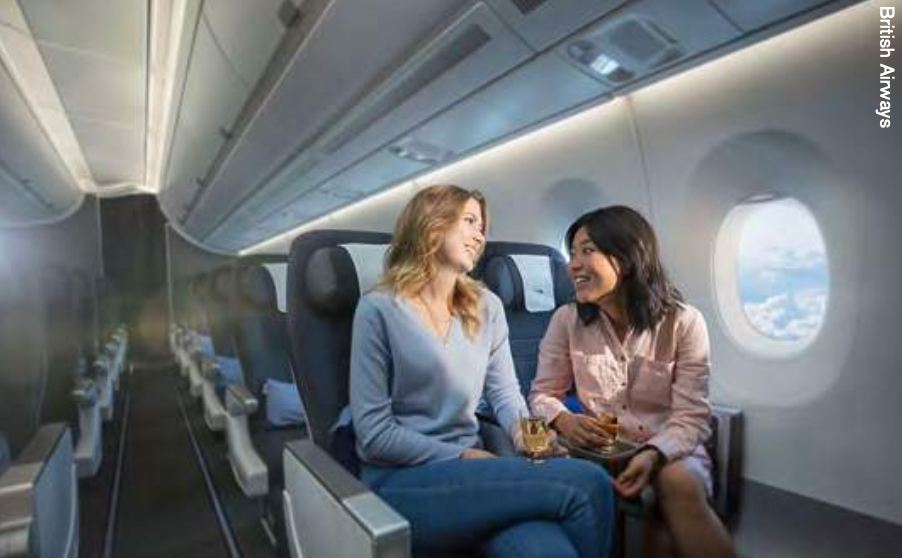
Pictured: In the Passenger Comfort category of the Crystal Cabin Awards, Adient Aerospace, in partnership with Boeing EnCore Interiors, unveiled the Ascent Front Suite. The suite removes the overhead bins and positions the seats towards the windows. One of the finalists for this year’s Crystal Cabin Awards is the HT-01 UAM cabin concept from Hyundai Transys, which features the ability to reconfigure four seats between 2x2 rows and four-seat facing groups. The seat backs of the front seat pairs feature a hinge mechanism that allows the seats to simply tilt to face the desired direction. STG Aerospace noted that “low-risk customization” appears to be popular with budget airlines that want to apply their signature colors and materials to reflect their brand image. Economy cabin areas with extra legroom and full first-class economy cabins, such as British Airways’ World Traveller Plus (pictured), allow airlines to offer passengers a premium product. Delays in deliveries across the English Channel due to Brexit were one of the reasons why Norfolk-based Mirus Aircraft Seating invested in new testing equipment at its headquarters.
Sustainability
While the cabin accounts for a relatively small proportion of an aircraft’s environmental impact, the industry still needs to demonstrate a positive attitude. From single-use plastics to seat recycling, simple wins, no matter how small, are what passengers can see, touch and connect with.
“Sustainability is an eternal topic”,“The industry is calling for collaboration, and it seems like we’re all ready to start this journey together,” said Rhian Bache of STG. “But the key question is: who can take the first step and lead the industry forward? While every company wants to be seen as taking action, greenwashing (false environmental propaganda) remains a widespread problem. Making progress together is the best option, but it seems that many suppliers are missing some of the nuances of the approach.”
“Weight reduction is an area that needs attention, but quantitative data across the product life cycle is needed to make real progress,” Bache explained. This life cycle analysis is complex, but not impossible. “Add to that the company’s three-category greenhouse gas emissions accounting scope,” he added.(From《Greenhouse Gas Protocol》GHG, Scope 1 is used to account for direct emissions from sources owned or controlled by the company. Scope 2 is used to account for indirect emissions from the production of purchased electricity, steam, heating or cooling. ) directive, product life cycle analysis is difficult for smaller suppliers, who may lack internal expertise or dedicated resources to track this data, and even have restrictions from airlines. Perhaps OEMs need to push this to achieve lasting improvements in their "Scope 3 emissions" (which include all other indirect emissions generated in the company's value chain, such as waste disposal.”
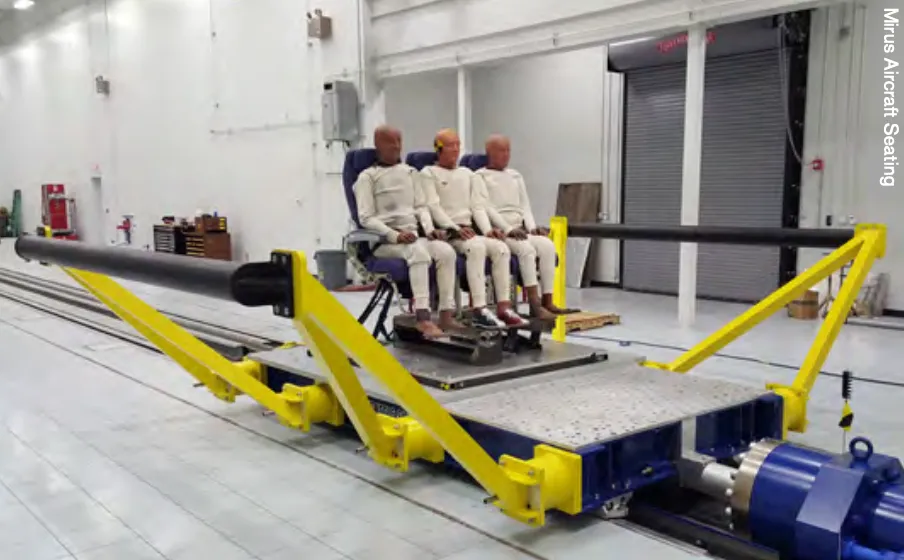
Chris Robinson, lightweight seating expert at Mirus, predictably refutes this: “As a seating supplier, we still believe that the most important thing in this area is to develop lighter weight components for air travel to save fuel.”
“In addition to this, we continue to invest in advanced material technologies to reduce the amount of plastic we use, replacing it with a variety of environmentally friendly foams and seat covering materials, including wool fabrics and sustainable leather alternatives.”
Chris Brady of Unum:“There is no one-size-fits-all solution to complex problems. Weight still reigns supreme, and material innovation is welcome, but what is often overlooked is procurement policy - the carbon emissions of a piece of aluminum can vary fourfold depending on how it is smelted (electrolysis is still the only process for industrial production of primary aluminum in the world, and hydroelectric aluminum emits 86% less carbon than thermal aluminum). The transportation of aluminum and aluminum products around the world may make sense in terms of strict cost control, but carbon emissions are rarely considered. A huge change in the way organizations make decisions is coming.”
“However, the aviation industry, which was in trouble in 2020, has shown great resilience and has now recovered significantly. It is worth noting that this recovery is limited by the shortage of aircraft, supply chain and labor.”
Collins Aerospace’s Mark Vaughan concluded: “Really, I think there are a lot of things to consider, including the resilience of global air travel in general, and how this may affect airlines’ ability to change their thinking significantly once it recovers, especially given that different regions are recovering at different speeds.”
